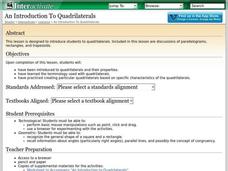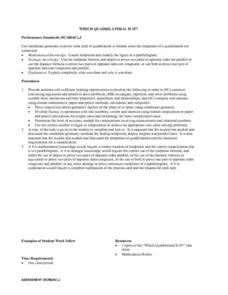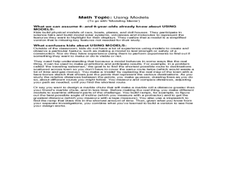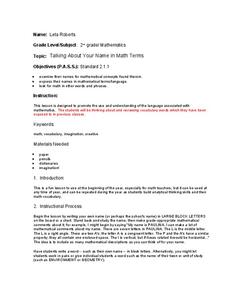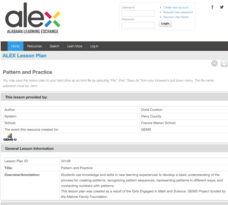Curated OER
Fractions and Paper Folding
In this fraction lesson, students manipulate paper by folding it to create different shapes and sizes, they explore the concept of fractions, and discuss their observations as a class. This is a great lesson for getting students...
Curated OER
Principles of Flight: Flying Paper Airplanes
Students investigate ways to enhance an object's flying ability. In this model construction lesson, students construct two paper airplanes, one of which is twice as big as the first. Students compare and contrast the two...
Curated OER
Add or Subtract Whole Numbers Up to 1000
Elementary schoolers solve practice problems on the board and are shown how to line up the numbers for addition. They solve various addition problems in small groups. Everyone continues the same process for solving subtraction problems.
Curated OER
The Trapping of Trapezoids
This is a nice hands-on activity where young geometers create trapezoids and calculate their area by looking at areas of quadrilaterals and triangles.
Curated OER
Lines, Lines, Everywhere
Students explore linear equation suing real life scenarios. In this algebra lesson plan, students find the slope and intercept of a line. They create table of values to plot their graph and draw conclusions.
Curated OER
Garden Scavenger Hunt
Second graders examine the metric system. In this metric system instructional activity, 2nd graders compare measurements of common objects in metric units. Students compete in a garden scavenger hunt.
Clean Up Australia
Why are Batteries Harmful to the Environment?
Open this lesson by reading together about primary and secondary batteries (such as nickel-cadmium cells), problems they can cause in the environment, and how humans can minimize the damage. Afterward, little ones examine a collection of...
Curated OER
An Introduction to Quadrilaterals
Students explore the concept of quadrilaterals. In this quadrilateral lesson, students play with a floor tile applet to see that there are many types and characteristics of quadrilaterals including parallelograms, trapezoids, rectangles,...
Curated OER
Which Quadrilateral Is It?
Students prove conjectures about geometric figures on the plane or in space using coordinate geometry. They develop fluency in operations with real numbers, vectors and matrices using mental computation or paper-and-pencil calculations...
Curated OER
Quadrilateral Explorations
Ninth graders identify quadrilaterals and label the vertices of quadrilaterals. they justify their identification of the quadrilaterals. Students work in groups to identify and create quadrilaterals
Curated OER
Quadrilateral Explorations-Grade Nine
Ninth graders investigate quadrilaterals. In this geometry lesson, 9th graders examine and classify quadrilaterals using the slope, midpoint and distance formulas. Additionally, students create various quadrilaterals given...
Curated OER
How many isosceles triangles can you find?
Seventh graders recognize the characteristics of isosceles triangles. In this isosceles triangle lesson, 7th graders use geoboards to create isosceles triangles. Students record results and explain why they have an isosceles triangle.
Curated OER
Preparation and Transition to Two-Column Proofs
Young scholars investigate proofs used to solve geometric problems. In this geometry lesson, students read about the history behind early geometry and learn how to write proofs correctly using two columns. The define terminology valuable...
Curated OER
Trigometric Ratios
This lesson requires a worksheet that is not connected. It is integral to the lesson.
Curated OER
Modeling Mania
Students describe techniques helpful in solving spatial problems which utilize the notion that a model is a simplified version of something complicated. They utilize methods such as sketching or drawing possible solutions to a problem.
Curated OER
Water Conservation
Students explore types of water reserves. In this water conservation lesson, students brainstorm ways water are used in their homes. Students use a graduated cylinder to simulate the amount of water on Earth and the amount that humans use.
Curated OER
Talking about your name in math terms
Students talk about mathematical language. For this talking about your name lesson, students use the letters in their own name to review math vocabulary and concepts.
Curated OER
One Good Turn Deserves Another
Students make observations about shapes and 1-, 2-, and 3-dimensional objects. They conduct observations and make predictions regarding transformations of simple geometric shapes. They identify shapes that occur in household items.
Curated OER
Anything I Can Do You Can Do Better
Students complete a two-week unit involving design and construction concepts. They watch a PowerPoint presentation about geometric shapes, draw the fourteen shapes incorporated in bridge construction, and in small groups design, build,...
Curated OER
WINDMILL POWER
Students study operations with real numbers using mental computation or paper-and-pencil calculations. They judge the reasonableness of numerical computations and their results. They set up and solve proportions for direct and inverse...
Alabama Learning Exchange
Pattern and Practice
Young scholars learn how to make patterns. Students first display their prior knowledge of patterns before delving into the lesson. They complete a worksheet and participate in a web-based class activity. They work in cooperative groups...
Curated OER
Partial Quotients
Fifth graders examine the partial-quotients algorithm for finding the answer to a division problem. In this partial quotients lesson, 5th graders demonstrate the process of division through a series of estimations....
Curated OER
Beads, Balls, and Beakers
Learners analyze the amount of space required to pack round objects. In this geometry activity, students practice using space economically by practicing packing spheres into beakers. They then translate this concept to molecules being...
Curated OER
Triangle Island
Students calculate the altitude of triangles. In the web based lesson, students explore the interior distance from a given point in a polygon to its side. They compute the sum of these lengths. Students read life...









